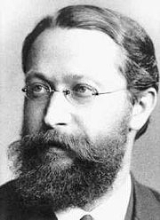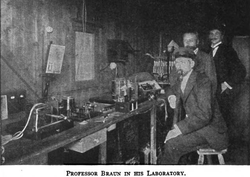
Karl Ferdinand Braun
Encyclopedia

Physicist
A physicist is a scientist who studies or practices physics. Physicists study a wide range of physical phenomena in many branches of physics spanning all length scales: from sub-atomic particles of which all ordinary matter is made to the behavior of the material Universe as a whole...
and Nobel laureate in physics
Nobel Prize in Physics
The Nobel Prize in Physics is awarded once a year by the Royal Swedish Academy of Sciences. It is one of the five Nobel Prizes established by the will of Alfred Nobel in 1895 and awarded since 1901; the others are the Nobel Prize in Chemistry, Nobel Prize in Literature, Nobel Peace Prize, and...
. Braun contributed significantly to the development of the radio and television technology: he shared with Guglielmo Marconi
Guglielmo Marconi
Guglielmo Marconi was an Italian inventor, known as the father of long distance radio transmission and for his development of Marconi's law and a radio telegraph system. Marconi is often credited as the inventor of radio, and indeed he shared the 1909 Nobel Prize in Physics with Karl Ferdinand...
the 1909 Nobel Prize in Physics
Nobel Prize in Physics
The Nobel Prize in Physics is awarded once a year by the Royal Swedish Academy of Sciences. It is one of the five Nobel Prizes established by the will of Alfred Nobel in 1895 and awarded since 1901; the others are the Nobel Prize in Chemistry, Nobel Prize in Literature, Nobel Peace Prize, and...
.
Biography
Braun was born in FuldaFulda
Fulda is a city in Hesse, Germany; it is located on the river Fulda and is the administrative seat of the Fulda district .- Early Middle Ages :...
, Germany, and educated at the University of Marburg and received a Ph.D. from the University of Berlin in 1872. In 1874 he discovered that a point-contact semiconductor
Semiconductor
A semiconductor is a material with electrical conductivity due to electron flow intermediate in magnitude between that of a conductor and an insulator. This means a conductivity roughly in the range of 103 to 10−8 siemens per centimeter...
rectifies
Rectifier
A rectifier is an electrical device that converts alternating current , which periodically reverses direction, to direct current , which flows in only one direction. The process is known as rectification...
alternating current
Alternating current
In alternating current the movement of electric charge periodically reverses direction. In direct current , the flow of electric charge is only in one direction....
. He became director of the Physical Institute and professor of physics
Physics
Physics is a natural science that involves the study of matter and its motion through spacetime, along with related concepts such as energy and force. More broadly, it is the general analysis of nature, conducted in order to understand how the universe behaves.Physics is one of the oldest academic...
at the University of Strassburg in 1895.
In 1897 he built the first cathode-ray tube
Cathode ray tube
The cathode ray tube is a vacuum tube containing an electron gun and a fluorescent screen used to view images. It has a means to accelerate and deflect the electron beam onto the fluorescent screen to create the images. The image may represent electrical waveforms , pictures , radar targets and...
(CRT) and cathode ray tube oscilloscope
Oscilloscope
An oscilloscope is a type of electronic test instrument that allows observation of constantly varying signal voltages, usually as a two-dimensional graph of one or more electrical potential differences using the vertical or 'Y' axis, plotted as a function of time,...
. CRT technology has been replaced by flat screen technologies (such as liquid crystal display
Liquid crystal display
A liquid crystal display is a flat panel display, electronic visual display, or video display that uses the light modulating properties of liquid crystals . LCs do not emit light directly....
(LCD), light emitting diode (LED) and plasma display
Plasma display
A plasma display panel is a type of flat panel display common to large TV displays or larger. They are called "plasma" displays because the technology utilizes small cells containing electrically charged ionized gases, or what are in essence chambers more commonly known as fluorescent...
s) on television sets and computer monitors. The CRT
Cathode ray tube
The cathode ray tube is a vacuum tube containing an electron gun and a fluorescent screen used to view images. It has a means to accelerate and deflect the electron beam onto the fluorescent screen to create the images. The image may represent electrical waveforms , pictures , radar targets and...
is still called the "Braun tube" in German-speaking countries (Braunsche Röhre) and in Japan (Buraun-kan).
During the development of radio
History of radio
The early history of radio is the history of technology that produced radio instruments that use radio waves. Within the timeline of radio, many people contributed theory and inventions in what became radio. Radio development began as "wireless telegraphy"...
, he also worked on wireless
Wireless
Wireless telecommunications is the transfer of information between two or more points that are not physically connected. Distances can be short, such as a few meters for television remote control, or as far as thousands or even millions of kilometers for deep-space radio communications...
telegraphy
Telegraphy
Telegraphy is the long-distance transmission of messages via some form of signalling technology. Telegraphy requires messages to be converted to a code which is known to both sender and receiver...
. In 1897 Ferdinand Braun joined the line of wireless pioneers. His major contributions were the introduction of a closed tuned circuit in the generating part of the transmitter, and its separation from the radiating part (the antenna) by means of inductive coupling, and later on the usage of crystals for receiving purposes. Wireless telegraphy claimed Dr. Braun's full attention in 1898, and for many years after that he applied himself almost exclusively to the task of solving its problems. Dr. Braun had written extensively on wireless subjects and was well known through his many contributions to the Electrician and other scientific journals. In 1899, he would apply for the patents, Electro telegraphy by means of condensers and induction colls and Wireless electro transmission of signals over surfaces.
Around 1898, he invented a crystal diode rectifier
Diode
In electronics, a diode is a type of two-terminal electronic component with a nonlinear current–voltage characteristic. A semiconductor diode, the most common type today, is a crystalline piece of semiconductor material connected to two electrical terminals...
or Cat's whisker diode
Cat's whisker diode
A cat’s whisker detector is an antique electronic component consisting of a thin wire that lightly touches a crystal of semiconducting mineral to make a crude point-contact rectifier. Developed by early radio researchers Jagadish Chandra Bose, G. W...
. Pioneers working on wireless devices eventually came to a limit of distance they could cover. Connecting the antenna directly to the spark gap produced only a heavily damped pulse train. There were only a few cycles before oscillations ceased. Braun's circuit afforded a much longer sustained oscillation because the energy encountered less losses swinging between coil and Leyden Jars. And by means of inductive antenna coupling the radiator was better matched to the generator. The resultant stronger and less bandwidth consuming signals bridged a much longer distance.
Braun's British patent on tuning was used by Marconi in many of his tuning patents. Guglielmo Marconi
Guglielmo Marconi
Guglielmo Marconi was an Italian inventor, known as the father of long distance radio transmission and for his development of Marconi's law and a radio telegraph system. Marconi is often credited as the inventor of radio, and indeed he shared the 1909 Nobel Prize in Physics with Karl Ferdinand...
used Braun's patents (among others). Marconi would later admit to Braun himself that he had "borrowed" portions of Braun's work. In 1909 Braun shared the Nobel Prize
Nobel Prize
The Nobel Prizes are annual international awards bestowed by Scandinavian committees in recognition of cultural and scientific advances. The will of the Swedish chemist Alfred Nobel, the inventor of dynamite, established the prizes in 1895...
for physics with Marconi for "contributions to the development of wireless telegraphy
Wireless telegraphy
Wireless telegraphy is a historical term used today to apply to early radio telegraph communications techniques and practices, particularly those used during the first three decades of radio before the term radio came into use....
." The prize awarded to Braun in 1909 depicts this design. Braun experimented at first at the University of Strasbourg. Not before long he bridged a distance of 42 km to the city of Mutzing. In spring 1899 Braun, accompanied by his colleagues Cantor and Zenneck, went to Cuxhaven to continue their experiments at the North Sea. On 24 September 1900 radio telegraphy signals were exchanged regularly with the island of Heligoland over a distance of 62 km. Lightvessels in the river Elbe and a coast station at Cuxhaven commenced a regular radio telegraph service.
Braun went to the United States at the beginning of World War I
World War I
World War I , which was predominantly called the World War or the Great War from its occurrence until 1939, and the First World War or World War I thereafter, was a major war centred in Europe that began on 28 July 1914 and lasted until 11 November 1918...
(before the U.S. had entered the war) to help defend the German wireless station at Sayville, New York
Sayville, New York
Sayville is a hamlet and CDP in Suffolk County, New York, . Located on the south shore of Long Island in the Town of Islip, the population of the CDP was 16,735 at the time of the 2000 census.-History:...
, against attacks by the British-controlled Marconi Corporation. After the US entered the war, Braun was being detained
Detention (imprisonment)
Detention is the process when a state, government or citizen lawfully holds a person by removing their freedom of liberty at that time. This can be due to criminal charges being raised against the individual as part of a prosecution or to protect a person or property...
, but could move freely within Brooklyn, New York. Braun died in his house in Brooklyn, before the war ended in 1918.
External links
- "Ferdinand Braun – Biography". Nobel Lectures. Physics 1901-1921, Elsevier Publishing Company, Amsterdam, 1967.
- Naughton, Russell, "Karl Ferdinand Braun, Dr : 1850 - 1918".
- "Karl Ferdinand Braun ". Biographies of Famous Electrochemists and Physicists Contributed to Understanding of Electricity.
- Rybak, James P., "Forgotten" Pioneers of Wireless; Part 5 - Karl Ferdinand Braun".
- "Karl Ferdinand Braun, 1850-1918". (German) (English translation)
- The Ferdinand-Braun-Institut fuer Hoechstfrequenztechnik Berlin, Germany
- Alfred Thomas Story A Story of Wireless Telegraphy. D. Appleton and company 1904

